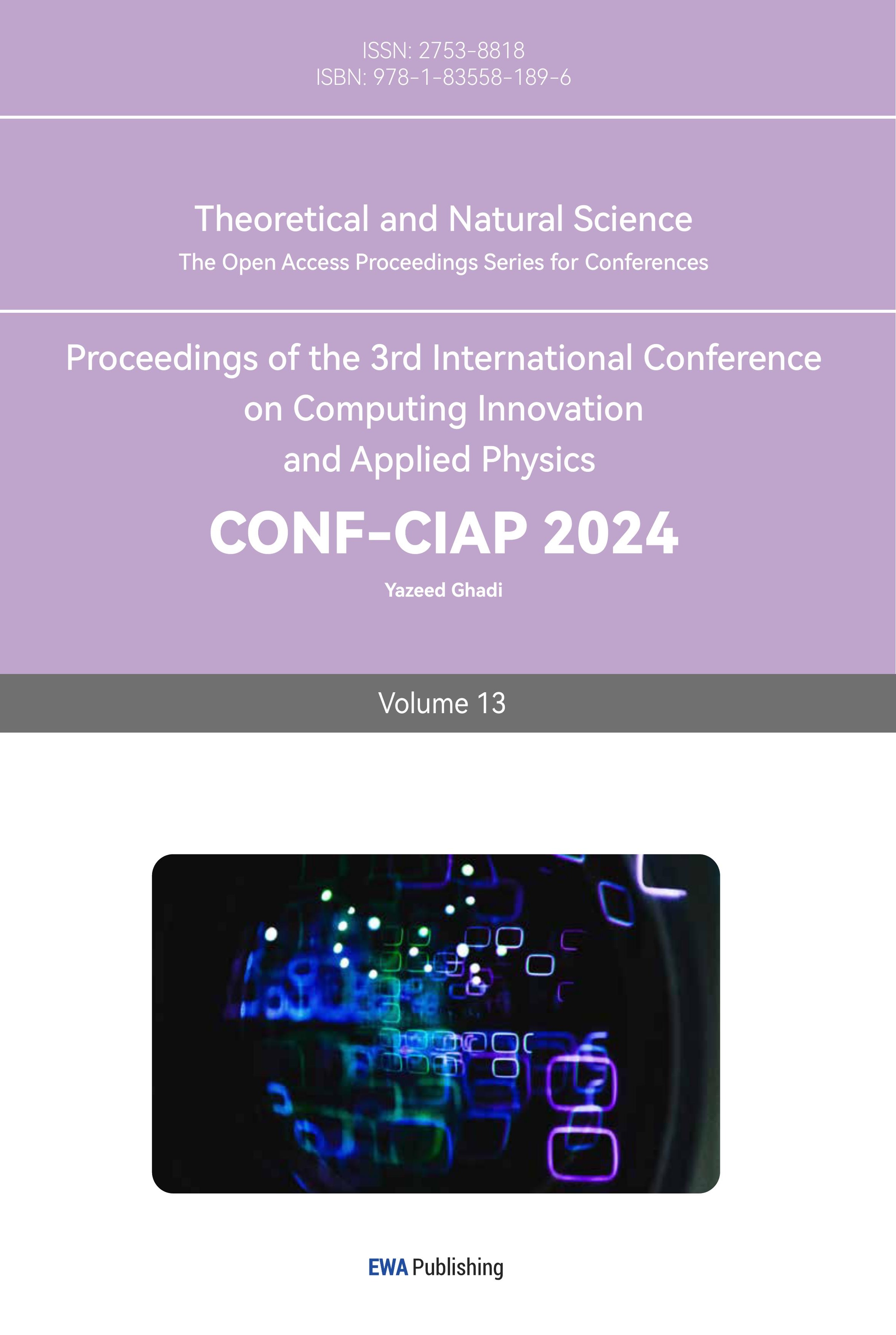1. Introduction
Micro aero-engines mainly include the following types: turbojet engines, turbofan engines, piston engines, and rotor engines. Micro-turbojet engine refers to a closed cycle gas turbine engine with thrust below 500kg and power below 100kW. The engine is characterized by a complete reliance on the gas flow to generate thrust. The micro-turbojet engine is comprised of compressor, combustion chamber, turbine, tail nozzle, and so on. The performance indicators of domestic products are relatively low, and the product series is not perfect enough to provide sufficient power support for the development of aircraft. The main problems of domestic products are low push-to-weight ratio, poor reliability, and low heat resistance. The low working efficiency of the components and the short life limit the performance of the aircraft.
In this paper, a micro-turbojet engine with a higher thrust-to-weight ratio and higher heat tolerance has been designed. Through the strength analysis by finite element simulation and the additive manufacturing technology, the hollow centrifugal impeller with a built-in skeleton structure is successfully developed. The integrated design of the evaporation tube guide and shaft sleeve diffuser not only has simple processing technology, but also solves the problems of poor stability and high production cost, reduces the heat loss between the evaporation tube and guide, and improves the overall efficiency of the engine. Ceramic matrix composite integral turbine disk has been successfully applied in aero-engine which has achieved breakthroughs in thrust-to-weight ratio, reliability, and heat tolerance of the engine. At present, the engine has been installed and tested to prove its feasibility. This paper has reference value for the development of modern micro turbojet engines.
2. Hollow centrifugal impeller with built-in skeleton structure
Turbojet compressors can be divided into axial flow, centrifugal, and hybrid types. Centrifugal compressor has compact structure and high single-stage pressurization ratio, which is mainly used in small and medium-sized aero-engines, ships and other fields. Impeller blade is one of the core parts of centrifugal compressor. It is subjected to the combined action of centrifugal load, thermal load and aerodynamic load under actual working conditions [1]. The impeller rotates with the spindle at high speed and does work on the gas. Under the action of the impeller blade, the gas rotates at a high speed with the impeller and is subjected to the action of rotating centrifugal force and diffusing flow in the impeller. When exiting the impeller, the pressure, speed, and temperature of the gas are increased, providing conditions for the next step into the combustion chamber. At present, the traditional centrifugal impeller on the market has the following problems: the outlet radius is large, the impeller with a solid hub structure is large, and the weight proportion of the blade is relatively low. As the small engine rotates at a high speed, the wheel hub bears a huge centrifugal load during the engine operation, resulting in reduced stability. These shortcomings limit the performance of micro engines.
In order to solve the problems above, the Institute of Engineering Thermophysics of the Chinese Academy of Sciences has developed a centrifugal compressor impeller. By modeling the inclination angle of the diverter blade and the main blade of the centrifugal impeller, the control of the airflow in the blade passage is realized. This method can optimize the different aerodynamic unbalanced forces of airflow in different blade channels respectively. By applying different blade forces at different inclination angles, the spanwise pressure gradient from the hub to the casing and the circumferential pressure gradient from the pressure surface to the suction surface can be reasonably balanced. Then the secondary flow structure inside the centrifugal impeller is improved and the uniformity of the flow field at the outlet is improved. This design improves the weight proportion of the blade, but it also increases the overall weight of the impeller.
The application of a hollow centrifugal impeller with a skeleton structure to the micro turbojet engine can reduce the overall weight of the centrifugal impeller and improve the working efficiency of the centrifugal compressor. The model is based on the condition that the original aerodynamic shape remains unchanged. A skeleton structure is added inside the hub to withstand the centrifugal load generated by the blades during rotation. The skeleton replaces the original solid structure, and in any plane perpendicular to the axial direction, the center line of the skeleton is a radial straight line segment, connecting the blade root and the shaft hole. The skeleton is symmetrical in shape with respect to the center line [2]. The skeleton structure is a complex structure inside the impeller, which is difficult to process using traditional methods. In recent years, due to the development of additive manufacturing technology, the difficulty of generating complex structures inside the object has been greatly reduced. At the same time, a powder-cleaning ring hole is arranged at the inlet of the impeller to connect the magnet base with each cavity in the wheel hub, so that the powder of the additive manufacturing scheme can be cleaned. Due to the particularity of the model in geometry, the weight is greatly reduced and the working efficiency of the centrifugal compressor is improved on the basis of meeting the corresponding load conditions. The compressor efficiency calculation determined that the compressor efficiency was 0.74. By using ABAQUS finite element software, the preliminary strength analysis of the turbine disc under centrifugal load and temperature load was carried out, the centrifugal impeller with a built-in skeleton structure can reduce the weight by 25.1% and increase the push-to-weight ratio by 12.2% [3]. At the same time, the overall maximum stress level does not exceed 110% of the maximum stress level of the corresponding solid structure centrifugal impeller in the design condition.
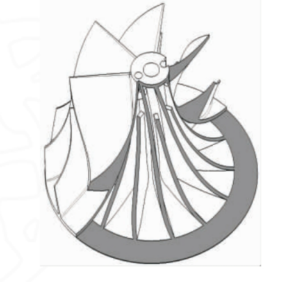
Figure 1. Modeling diagram of hollow centrifugal impeller with built-in skeleton structure [1].
3. Integrated design of evaporator tube guide and shaft sleeve diffuser
In an aero-engine, the guide can effectively increase turbine front temperature, reduce turbine end wall loss and improve turbine efficiency. The evaporative tube has the advantages of a simple structure, easy processing, low cost, and good comprehensive combustion performance. At present, the guide and the evaporation tube are used as different parts in the aero-engine, and their connection is spliced or bolted, which leads to poor stability, while generating heat loss, reducing the overall efficiency of the engine. When the bushing and diffuser are working, the fixed effect is achieved through the connection of four threads. When the bushing is rotating, the force is transmitted through the fastener to complete the driving of the diffuser, so that the gas turbine engine can complete continuous work. The connection between the shaft sleeve and the impeller of this traditional connection structure requires a large number of parts, which is complicated to manufacture and has low stability during operation [4].
In order to solve the problems above, this paper adopts the integrated design of the evaporator tube guide of the turbojet engine. The structure comprises a guide wheel rim, a guide blade and a sealing disc. The guide blade is arranged in a ring cavity formed by the rim and the sealing disc. One end of the guide blade is fixed connected with the rim, and the other end of the blade is fixed connected with the sealing disc. The upper surface of the wheel rim is provided with an evaporation tube connecting ring, the evaporation tube connecting ring is provided with a straight evaporation tube, and the straight evaporation tube is provided with a nozzle. The outer wall of the wheel rim of the guide is provided with a fixed thin plate and a fixed connecting hole is provided on the fixed thin plate. The design overcomes the problems of poor stability of the connection between the guide and the evaporation tube. The overall efficiency is increased by more than 10%. The rotor dynamic balance test shows that the vibration level of the whole machine is low, and the engine stability is greatly improved [5].
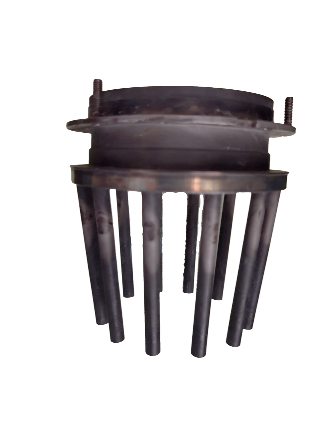
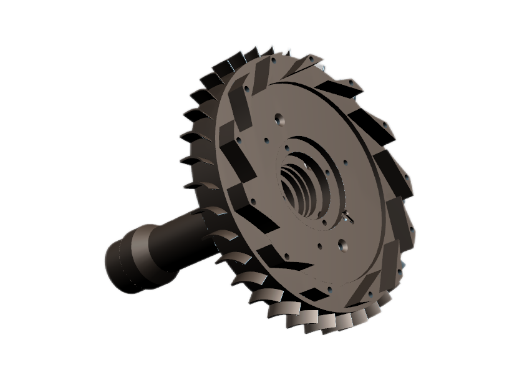
Figure 2. Integrated design physical drawing.
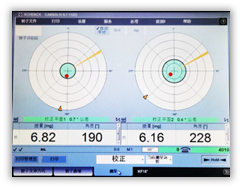
Figure 3. Rotor dynamic balance test.
4. Ceramic matrix composite integral turbine blade disc
To increase the thrust-weight ratio of aero-engine, it is necessary to continuously reduce the structural weight of engine and improve the heat resistance of engine components. Therefore, the development of new ultra-high temperature composite materials with high heat resistance and low density to replace high-temperature alloys and refractory metal materials has become the key and basis for the development of high-performance engines. The natural frequency characteristics and internal damage evolution of braided SiC/SiC composites are studied by cyclic loading and unloading tests at room temperature [6]. It is found that CMC-SiC has the characteristics of high specific strength, high specific modulus, high temperature resistance, ablation resistance, oxidation resistance and low density. Its density is 2~2.5g /cm3, which is only 1/3~1/4 of superalloy and niobium alloy, and 1/9~1/10 of tungsten alloy. C/SiC can be used in limited-life (2 000~2 200 ℃) and long-life(1 650 ℃) aero-engines [7].
It has been proved that ceramic matrix composites are reliable and stable. The turbojet engine applies the ceramic matrix composite material to the turbine disc as a whole, the instantaneous temperature of the turbine front is increased to 1400K, the instantaneous thrust is up to 25daN, the maximum working temperature of the ceramic compressor blade is up to 1500℃, and the application reliability is greatly improved. The ceramic shell is freely installed on the metal chip to complete the integrated design of the combination of ceramic and metal materials, and the comprehensive use of the excellent heat resistance of ceramic materials and the high tensile strength of metal materials [8]. According to the characteristics of ceramic materials, a number of unique structures, with the advantages of convenient dynamic balance to remove materials, enhance shear resistance, and avoid blade tip scratching. The reliability and safety of ceramic turbine disk assembly and operation are improved. The material withstand temperature is increased by 20%, the thrust-weight ratio is increased by 12.2%, and the overall weight of the components is reduced by 70%. The turbine efficiency calculation determines that the turbine efficiency is 0.82. It is the first time that the ceramic matrix composite turbine disk has been applied to the turbojet engine in China [9]. The micro-mini turbojet engine has been tested on the ground for more than 30 times. Based on the design software, 24 sets of data from 12 aspects are used to verify that the engine’s thrust, and the fuel consumption reaches the expected design effect, further confirming its breakthroughs in thrust to weight ratio and working stability [10].
5. Conclusion
This paper studies a new type of micro-turbojet engine. For the first time, selective laser melting additive manufacturing of rotor parts has been successfully applied to engines. The core centrifugal impeller with built-in skeleton structure greatly improves the thrust-weight ratio of the engine. The integrated design of evaporator tube guide and shaft sleeve diffuser not only has simple processing technology, but also solves the problems of poor stability and high production cost, reducing the heat loss between evaporator tube and guide, and improving the overall efficiency of engine. Ceramic matrix composite integral turbine disk has been successfully applied in aero-engine, increasing the limit temperature and decreasing the overall weight.
References
[1]. TANG Xin-Zi, XIAO Peng, WANG Zhe, Peng Rui-Tao. Aerodynamic Optimal Design of Centrifugal Compressor Impeller Under Multi-Load Deformation Condition. JOURNAL OF ENGINEERING THERMOPHYSICS,2019,40(8):1741-1750.
[2]. ZHANG XI-hao, HUANG Yi-zhou, LIU Zheng-xu. Strength Analysis of Aeroengine Turbine Disk Based on ABAQUS. MECHANICAL ENGINEERING & AUTOMATIONM,2022(1):112-114.
[3]. Zhao Gao-le,Cheng Mu-wei,Hu Xiao-an,et al. Research on weight reduction design method for compressor of a small turbojet engine.ADVANCESIN AERONAUTICAL SCIENCE AND ENGINEERING, 2019,10(2):228-233.
[4]. LIU Shu-tian, LI Qu-hao, CHEN Wen-jiong, ZHANG Yong-cun. Combination of Topology Optimization and Additive Manufacturing: an Integration Method of Structural Design and Manufacturing. Aviation Precision Manufacturing Technology,2017(10):26-31.
[5]. YANG Hua. Numerical Investigation on Centrifugal Compressor and Diffuser Design. Ins titute of Engineering Thermophysics, Chinese Academy of Sciences ,2005.
[6]. WANG Jia-hui, WU Jin-wu ,GUO Xiao-jun, HU Xiao-an, LI Long-biao, WANG Hai-tao. Analysis of Structural Natural Frequency and Internal Damage of Ceramic Matrix Composites. Failure Analysis and Prevention,2021,16(3):177-183.
[7]. JIANG Tao, Research and Development Status and Trend of the Ti-Si Intermetallics Compounds/Ceramics Matrix Composites. CHINA CERAMIC INDUSTRY,2022,29(5): 45-53.
[8]. ZHANGLi-tong, CHENG Lai-fei, XU Yong-dong. Progress in Research Work of New CMC-SiC . Aviation Precision Manufacturing Technology,2003(1):24-32.
[9]. HU Dian-yin ,PAN Jin-chao, MI Dong, YAN Cheng, WANG Rong-qiao. Strength and lifetime assessment and design for additive manufacturing structures in aero-engine: review and prospects. Journal of Aerospace Power,2022,37(10):2112-2126.
[10]. ZHANG Shu-gang, GUO Ying-qing, LU Jun. Research on aircraft engine component-level models based on GasTurb/MATLAB. Journal of Aerospace Power,2012,27(12):2850-2856.
Cite this article
Chen,J. (2023). Study on micro-turbojet engine with high thrust-to-weight ratio. Theoretical and Natural Science,13,121-125.
Data availability
The datasets used and/or analyzed during the current study will be available from the authors upon reasonable request.
Disclaimer/Publisher's Note
The statements, opinions and data contained in all publications are solely those of the individual author(s) and contributor(s) and not of EWA Publishing and/or the editor(s). EWA Publishing and/or the editor(s) disclaim responsibility for any injury to people or property resulting from any ideas, methods, instructions or products referred to in the content.
About volume
Volume title: Proceedings of the 3rd International Conference on Computing Innovation and Applied Physics
© 2024 by the author(s). Licensee EWA Publishing, Oxford, UK. This article is an open access article distributed under the terms and
conditions of the Creative Commons Attribution (CC BY) license. Authors who
publish this series agree to the following terms:
1. Authors retain copyright and grant the series right of first publication with the work simultaneously licensed under a Creative Commons
Attribution License that allows others to share the work with an acknowledgment of the work's authorship and initial publication in this
series.
2. Authors are able to enter into separate, additional contractual arrangements for the non-exclusive distribution of the series's published
version of the work (e.g., post it to an institutional repository or publish it in a book), with an acknowledgment of its initial
publication in this series.
3. Authors are permitted and encouraged to post their work online (e.g., in institutional repositories or on their website) prior to and
during the submission process, as it can lead to productive exchanges, as well as earlier and greater citation of published work (See
Open access policy for details).
References
[1]. TANG Xin-Zi, XIAO Peng, WANG Zhe, Peng Rui-Tao. Aerodynamic Optimal Design of Centrifugal Compressor Impeller Under Multi-Load Deformation Condition. JOURNAL OF ENGINEERING THERMOPHYSICS,2019,40(8):1741-1750.
[2]. ZHANG XI-hao, HUANG Yi-zhou, LIU Zheng-xu. Strength Analysis of Aeroengine Turbine Disk Based on ABAQUS. MECHANICAL ENGINEERING & AUTOMATIONM,2022(1):112-114.
[3]. Zhao Gao-le,Cheng Mu-wei,Hu Xiao-an,et al. Research on weight reduction design method for compressor of a small turbojet engine.ADVANCESIN AERONAUTICAL SCIENCE AND ENGINEERING, 2019,10(2):228-233.
[4]. LIU Shu-tian, LI Qu-hao, CHEN Wen-jiong, ZHANG Yong-cun. Combination of Topology Optimization and Additive Manufacturing: an Integration Method of Structural Design and Manufacturing. Aviation Precision Manufacturing Technology,2017(10):26-31.
[5]. YANG Hua. Numerical Investigation on Centrifugal Compressor and Diffuser Design. Ins titute of Engineering Thermophysics, Chinese Academy of Sciences ,2005.
[6]. WANG Jia-hui, WU Jin-wu ,GUO Xiao-jun, HU Xiao-an, LI Long-biao, WANG Hai-tao. Analysis of Structural Natural Frequency and Internal Damage of Ceramic Matrix Composites. Failure Analysis and Prevention,2021,16(3):177-183.
[7]. JIANG Tao, Research and Development Status and Trend of the Ti-Si Intermetallics Compounds/Ceramics Matrix Composites. CHINA CERAMIC INDUSTRY,2022,29(5): 45-53.
[8]. ZHANGLi-tong, CHENG Lai-fei, XU Yong-dong. Progress in Research Work of New CMC-SiC . Aviation Precision Manufacturing Technology,2003(1):24-32.
[9]. HU Dian-yin ,PAN Jin-chao, MI Dong, YAN Cheng, WANG Rong-qiao. Strength and lifetime assessment and design for additive manufacturing structures in aero-engine: review and prospects. Journal of Aerospace Power,2022,37(10):2112-2126.
[10]. ZHANG Shu-gang, GUO Ying-qing, LU Jun. Research on aircraft engine component-level models based on GasTurb/MATLAB. Journal of Aerospace Power,2012,27(12):2850-2856.





